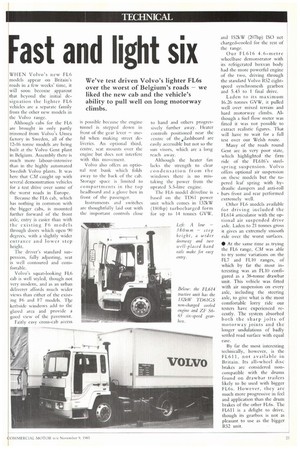Fast and light six
Page 25

If you've noticed an error in this article please click here to report it so we can fix it.
We've test driven Volvo's lighter FL6s over the worst of Belgium's roads — we liked the new cab and the vehicle's ability to pull well on long motorway climbs.
WHEN Volvo's new FL6 models appear on Britain's roads in a few weeks' time, it will soon become apparent that beyond the initial designation the lighter FL6 vehicles are a separate family from the other new models in the Volvo range.
Although cabs for the FL6 are brought in only partly trimmed from Volvo's Umea factory in Sweden, all of the 12-16 tonne models are being built at the Volvo Gent plant in Belgium. Assembly there is much more labour-intensive than in the highly automated Swedish Volvo plants. It was here that CM caught up with several demonstration vehicles for a test drive over some of the worst roads in Europe.
Because the FL6 cab, which has nothing in common with the bigger cabs, is mounted further forward of the front axle, entry is easier than with the existing F6 models through doors which open 90 degrees, with a slightly wider entrance and lower step height.
The driver's standard suspension, fully adjusting, seat is well contoured and comfortable.
Volvo's squat-looking FL6 cab is well styled, though not very modern, and as an urban deliverer affords much wider views than either of the existing F6 and F7 models. `Ikie kerbside windows add to the glared area and provide a good view of the pavement.
Fairly easy cross-cab access is possible because the engine tunnel is stepped down in front of the gear lever — useful when making street deliveries. An optional third, centre, scat mounts over the engine but does not interfere with this movement.
Volvo also offers an optional rest bunk which folds away to the hack of the cab. Storage space is limited to compartments in the top headboard and a glove box in front of the passenger.
Instruments and switches are thoughtfully laid out with the important controls close
to hand and others progressively further away. Heater controls positioned near the centre of the *dashboard are easily accessible but not so the sun visors, which arc a long reach away.
Although the heater fan lacks the strength to clear condensation from the windows there is no mistaking the power from the uprated 5.5-litre engine.
The I-16 model driveline is based on the TIM] power unit which comes in 132kW (180hp) turbocharged form for up to 14 tonnes GVW, and 152kW (207hp) ISO net charged-cooled for the rest of the range.
Our FL6 1 6 4.6-metre wheelbase demonstrator with its refrigerated boxvan body had the more powerful engine of the two, driving through the standard Volvo R52 eightspeed synchromesh gearbox and 5.43 to 1 final drive.
Laden to its maximum 16.26 tonnes GVW, it pulled well over mixed terrain and hard motorway climbs. Although a fuel flow meter was fitted it was not possible to extract realistic figures. That will have to wait for a full test over our Welsh route.
Many of the roads round Gent are in very poor state, which highlighted the firm ride of the FL616's steelspring suspension. Volvo offers optional air suspension on these models but the tapered leaf spring with hydraulic dampers and anti-roll • bars front and rear performed extremely well.
Other FL6 models available for driving included the FL614 articulator with the optional air suspended drive axle. Laden to 21 tonnes gross it gives an extremely smooth ride over the worst surfaces.
• At the same time as trying the FL6 range, CM was able to try some variations on the FL7 and FL10 ranges, of which by far the most interesting was an FL10 configured as a 38-tonne drawbar unit. This vehicle was fitted with air suspension on every axle, including the steering axle, to give what is the most comfortable lorry ride our testers have experienced recently. The system absorbed both the sharp jolts of motorway joints and the longer undulations of badly settled road surface with equal ease.
By far the most interesting technically, however, is the FL6 11, not available in Britain. Its all-wheel disc brakes arc considered noncompatible with the drums found on drawbar trailers likely to be used with bigger FL6s. However, they are much more progressive in feel and application than the drum brakes of the other FL6s. The FL611 is a delight to drive, though its gearbox is not as pleasant to use as the bigger R52 unit.












































































































































